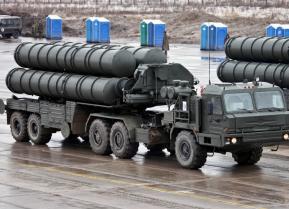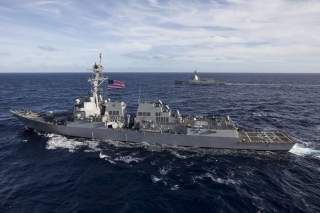How the U.S. Navy Forgot to Fight
The U.S. Navy is suffering from self-inflicted strategic dysfunction across the breadth of its enterprise.
The Navy has allowed the technical complexity of its ships and the flexibility of naval power to overwhelm the ability of Sailors to effectively train for war. Miscellaneous administrative burdens have also ballooned. Risk aversion has been mistaken for due diligence where a risk averse culture prone to adding training and inspections sought to mitigate risk that should have been accepted. Now it has become impossible to expect Sailors to become skilled at core warfighting tasks when there are too many boxes to check.
The training certification system has become so backward it is inhibiting the very sort of skill it should be promoting. According to Vice Admiral Joseph Tofalo, recent commander of the U.S. submarine force, they were “…really working hard by taking a hard scrub of our assessment and certification process” just to make only 10-15 days’ worth of time to insert high-end threat training into the months-long workup cycles of submarines. The bloated certification system is suffocating the ability of senior leaders to implement meaningful training reform.
But even with a bloated system why is it such a struggle for the Navy to make so little time for one of the most important types of training there is?
Training and Evaluation
“You cannot allow any of your people to avoid the brutal facts. If they start living in a dream world, it’s going to be bad.”–James Mattis
Most of the Navy’s training is not actually training in the fullest sense of the term. Rather, most events appear to be readiness evaluations. The intent of a readiness evaluation is not necessarily to create an in-depth learning experience, but to pass an event and earn a certification that indicates a unit is competent at a certain task. The term “certification” is almost always used in relation to the intent and end result of Navy training. Sailors in the fleet are often worrying about maintaining their numerous certifications because they require periodic refreshing.
Good training is about pushing to failure, testing limits, and taking risk head on. This makes it necessary to have training events that do not culminate in a pass/fail evaluation that can reflect poorly on a participant. When under evaluation one will likely fall back on previously known methods instead of using the opportunity to try something new. By frequently conflating readiness evaluations with training the Navy has failed to create enough space where Sailors can safely experiment and learn from their mistakes.
A singular focus on certification can encourage scripting because the goal simply becomes passing the next event rather than genuine improvement over time. Scripting away risk makes the chances of passing certification events much better. Yet much of the point of military skill is in knowing how to manage violent risk.
The Navy’s scripted style of training calls the trustworthiness of the certification system into question. In reference to unit-level training LT Erik Sand described a training and reporting system that allowed for “easy gaming and cheating” and that “because ships design their own drills, they can hide their weaknesses.” Ships were able to write the training packages they would be evaluated on and rehearse them enough to minimize surprise in advance of their inspections. LT Sand felt compelled to argue for the obvious: “In combat, a ship cannot pick where she takes a hit. The crew should not be able to do so in an inspection…the ship’s crew should not have specific foreknowledge of drill scenarios.” The end result was not an inspection process that seriously tests warfighting skill, but instead “evaluates the crew’s ability to stage-manage a show.”
The quality of any certification is based on the standard of training it was earned through. How credible is a warfighting certification earned through scripted training?
Comparing Chinese Navy Training
“He who can modify his tactics in relation to his opponent and thereby succeed in winning, may be called a heaven-born captain.” –Sun Tzu, The Art of War
Winning is not about being the best, but simply being better than the opposition. In this vein, how does the U.S. Navy stack up against its chief rival, the Chinese Navy?
The Office of Naval Intelligence (ONI) regularly releases unclassified reports on foreign navies. Its reports on the Chinese Navy (People’s Liberation Army Navy – PLAN) criticize training shortcomings that the U.S. Navy is itself committing. However, these reports also paint a picture of a force that is serious about training harder and working to overcome past disregard for realism.
In its 2015 report ONI stated the PLAN is “rectifying training methods by avoiding formalism and scripting in exercises.” As it looks to improve, less scripted training events that aim to “stress tactical flexibility, are occurring on a regular basis…” ONI’s 2007 report indicates the PLAN was making similar reforms earlier. The report said a limitation of the PLAN was its “reliance on scripted training events” and that new training guidance emphasized opposition force training and injecting surprise. In what the PLAN calls Naval Combat Readiness Exercises the exercise plan is “kept from the unit being exercised until just before orders are issued, or until the warning or signal is given.” The 2015 report said that a key goal of opposing force training exercises happening “on a regular basis” is “to evaluate a leader’s ability to develop and execute operational plans according to loosely defined objectives.”
Compare this to how Admiral Swift described the reaction of U.S. Sailors being presented with a Fleet Problem exercise: “Some teams clearly were uncomfortable, looking for the gouge on how the problem would go down. Many seemed astonished that the part of the order tasking them (‘Here is my intent. Your charge is to develop the required tasks to achieve it.’) often was less than a page long.” Swift said the fleet staff had to urge these leaders several times to “Stop asking for the plan; plan your solution.”
The 2007 ONI report noted that “Typically, PLAN units previously conducted only one training subject per sortie in a building block approach” and that under new training standards units “now conduct more than one training subject per sortie.”
Compare this to how Admiral Swift described Navy training in hisrecent writing, in that “Much of the process of unit training certification consists of performing individual techniques, often in a set sequence and a reduced tempo. In a fight, these techniques need to be combined and executed with speed.”
In addition to being chief of intelligence for U.S. Pacific Fleet Captain Rielage also serves as the senior member of the Pacific Naval Aggressor Team (PNAT) that was created a few years ago. PNAT seeks to incorporate intelligence insights on adversaries to create accurate representations of their thinking and behavior. PNAT then puts these insights into practice by leading opposing forces in certain events such as the Fleet Problems where Admiral Swift says PNAT “frequently surprises” leaders all the way up to the four-star level “unlike current strike group training.” Capt. Rielage also has interesting insights into how Chinese Navy training is evolving.
In “Chinese Navy Trains and Takes Risks” Rielage writes that PLAN units often engage in force-on-force exercises that incorporate key elements of surprise such as where live opposing forces do not know the “exact composition or disposition of the adversary.” Units that exercise initiative to increase the difficulty of their training events are regularly praised in official PLAN media. According to Rielage, “The clear impression is that the PLAN is more willing to accept risk in its training evolutions than its U.S. counterparts.”
There is also a stark difference in the sort of missions the U.S. Navy and the Chinese Navy are focused on training for. Rielage claims the PLAN is “underpinned by an institutional emphasis on training for high-end naval warfare” and that “there is a strong argument that success in this mission is the PLAN’s primary and defining priority.” Compare this to how Admiral Swift characterized U.S. Navy training in the power projection era:
“A quick glance at a Composite Training Unit or Joint Task Force exercise schedule showed maritime interdiction operations, strait transits, and air wings focused on power projection from sanctuary. But despite the best efforts of our training teams, our deploying forces were not preparing for the high-end maritime fight and, ultimately, the U.S. Navy’s core mission of sea control.”
For years the U.S. Navy has not tried to practice destroying modern fleets, but the Chinese Navy has.
The importance the PLAN places on training is also reflected in its leadership. While serving as Commandant of the Naval Command College and prior to becoming the current chief of the PLAN Admiral Shen Jinlong helped create a “Blue Force Center” that seeks to improve the realism of opposition force training. Earlier in his career he served as director of a naval vessels training center and was credited for establishing a training system for new-type ships. The current leader of the Chinese Navy is no stranger to training innovation.
The rate of tactical learning in the PLAN compared to most other navies is especially high, and not just because of its training values. With a hint of condescension the 2015 ONI report said that before the PLAN expanded its distant operations in 2009 it was “largely a training fleet, with very little operational experience.” But a force focused on hard and realistic training can certainly be effective when it will count most in war. The PLAN still has very few steady overseas commitments, and can afford to spend the bulk of its readiness on force development just like the interwar period U.S. Navy. On the other hand the modern U.S. Navy is stretched thin across the globe, and chooses to spend most of its readiness on overseas operations which are not the same as focused force development conducted close to home. The American and Chinese Navies have been spending their time on very different priorities.


